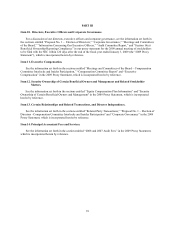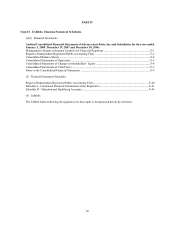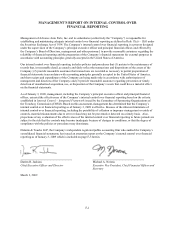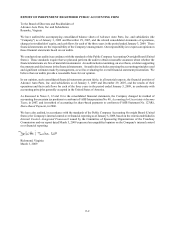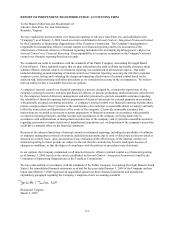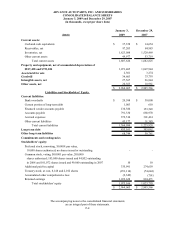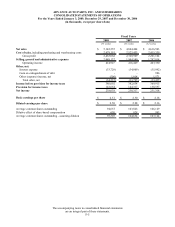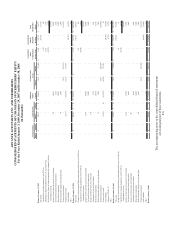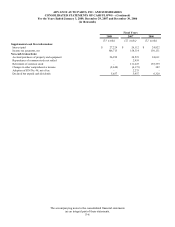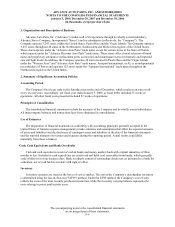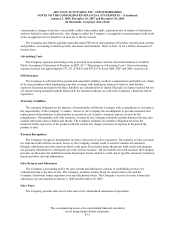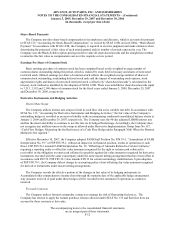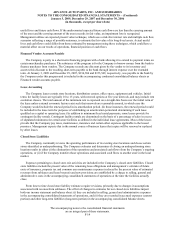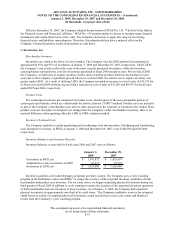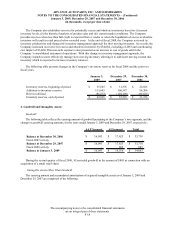Advance Auto Parts 2008 Annual Report Download - page 63
Download and view the complete annual report
Please find page 63 of the 2008 Advance Auto Parts annual report below. You can navigate through the pages in the report by either clicking on the pages listed below, or by using the keyword search tool below to find specific information within the annual report.ADVANCE AUTO PARTS, INC. AND SUBSIDIARIES
NOTES TO THE CONSOLIDATED FINANCIAL STATEMENTS
January 3, 2009, December 29, 2007 and December 30, 2006
(in thousands, except per share data)
The accompanying notes to the consolidated financial statements
are an integral part of these statements.
F-9
1. Organization and Description of Business:
Advance Auto Parts, Inc. (“Advance”) conducts all of its operations through its wholly owned subsidiary,
Advance Stores Company, Incorporated (“Stores”) and its subsidiaries (collectively, the “Company”). The
Company operates 3,243 stores within the United States, Puerto Rico and the Virgin Islands. The Company operates
3,215 stores throughout 40 states in the Northeastern, Southeastern and Midwestern regions of the United States.
These stores operate under the “Advance Auto Parts” trade name except for certain stores in the State of Florida
which operate under the “Advance Discount Auto Parts” trade name. These stores offer a broad selection of brand
name and proprietary automotive replacement parts, accessories and maintenance items for domestic and imported
cars and light trucks. In addition, the Company operates 28 stores located in Puerto Rico and the Virgin Islands
under the “Western Auto” and “Advance Auto Parts” trade names. Autopart International, or AI, is an independently
run subsidiary of Stores and operates 125 stores under the “Autopart International” trade name throughout the
Northeastern region of the United States.
2. Summary of Significant Accounting Policies:
Accounting Period
The Company's fiscal year ends on the Saturday nearest the end of December, which results in an extra week
every several years. Accordingly, our fiscal year ended January 3, 2009, or fiscal 2008, included 53 weeks of
operations. All other fiscal years presented included 52 weeks of operations.
Principles of Consolidation
The consolidated financial statements include the accounts of the Company and its wholly owned subsidiaries.
All intercompany balances and transactions have been eliminated in consolidation.
Use of Estimates
The preparation of financial statements in conformity with accounting principles generally accepted in the
United States of America requires management to make estimates and assumptions that affect the reported amounts
of assets and liabilities and the disclosure of contingent assets and liabilities at the date of the financial statements
and the reported amounts of revenues and expenses during the reporting period. Actual results could differ
materially from those estimates.
Cash, Cash Equivalents and Bank Overdrafts
Cash and cash equivalents consist of cash in banks and money market funds with original maturities of three
months or less. Included in cash equivalents are credit card and debit card receivables from banks, which generally
settle within two to four business days. Bank overdrafts consist of outstanding checks not yet presented to a bank for
settlement, net of cash held in accounts with right of offset.
Inventory
Inventory amounts are stated at the lower of cost or market. The cost of the Company’s merchandise inventory
is determined using the last-in, first-out ("LIFO") method. Under the LIFO method, the Company’s cost of sales
reflects the costs of the most recently purchased inventories, while the inventory carrying balance represents the
costs relating to prices paid in prior years.


